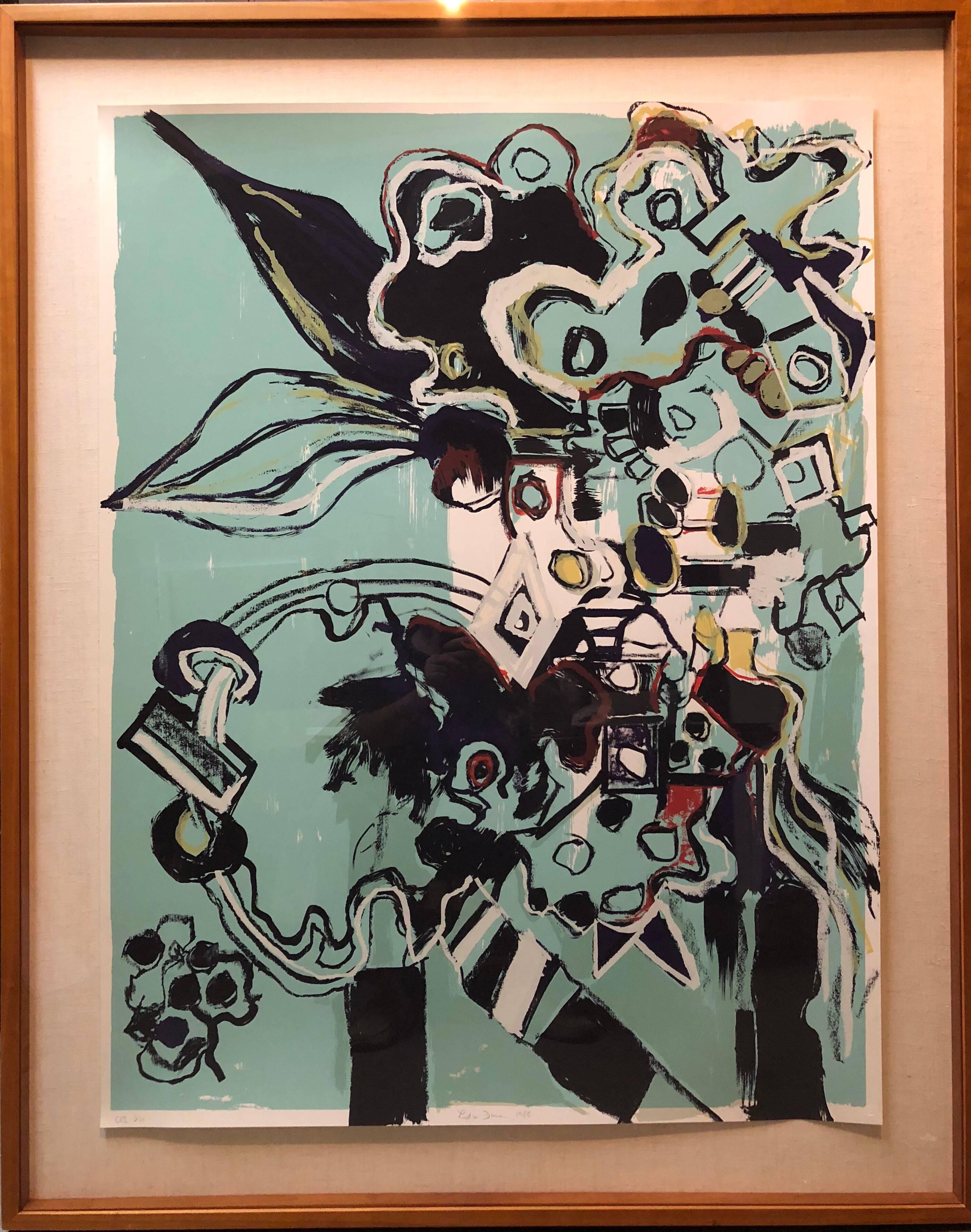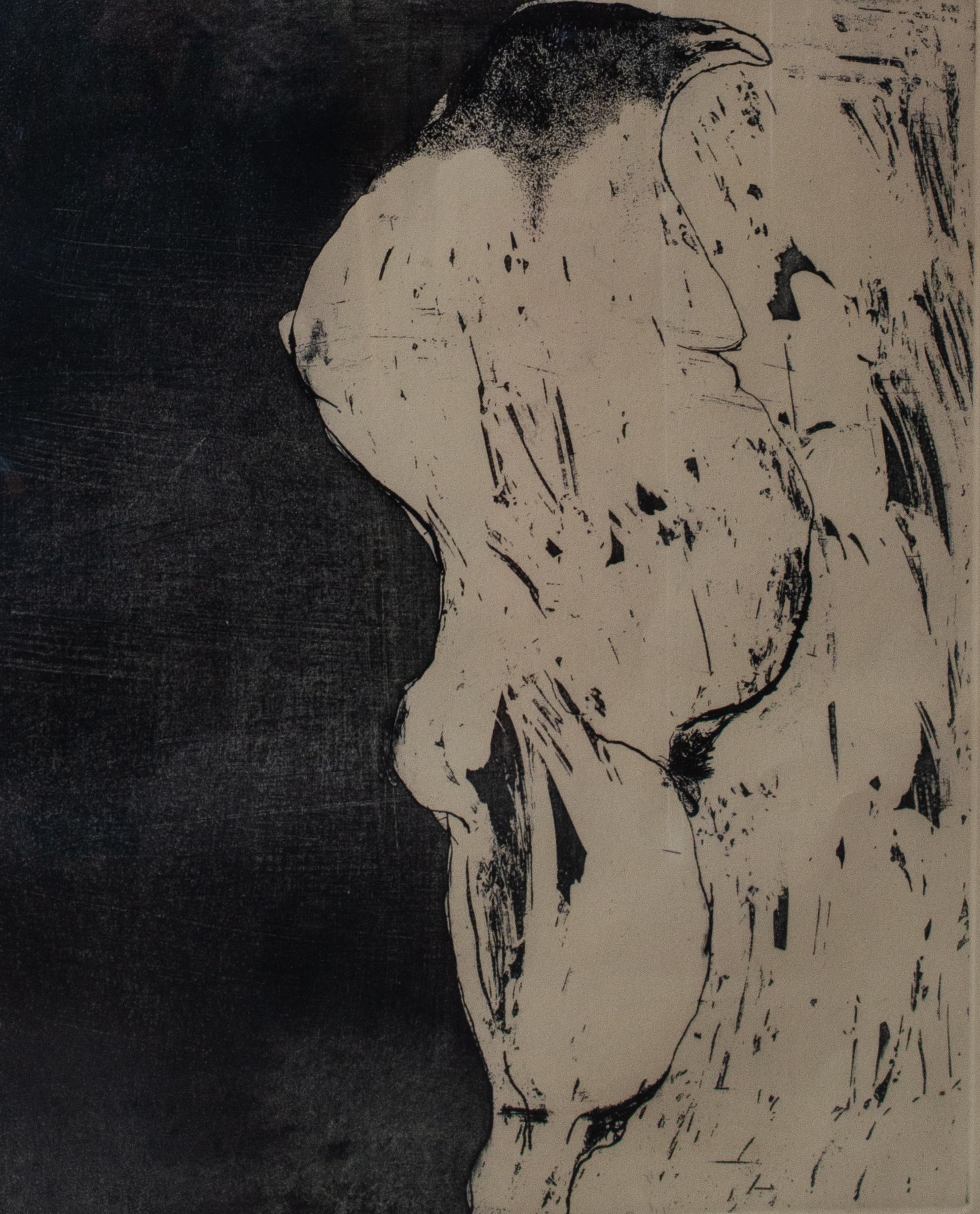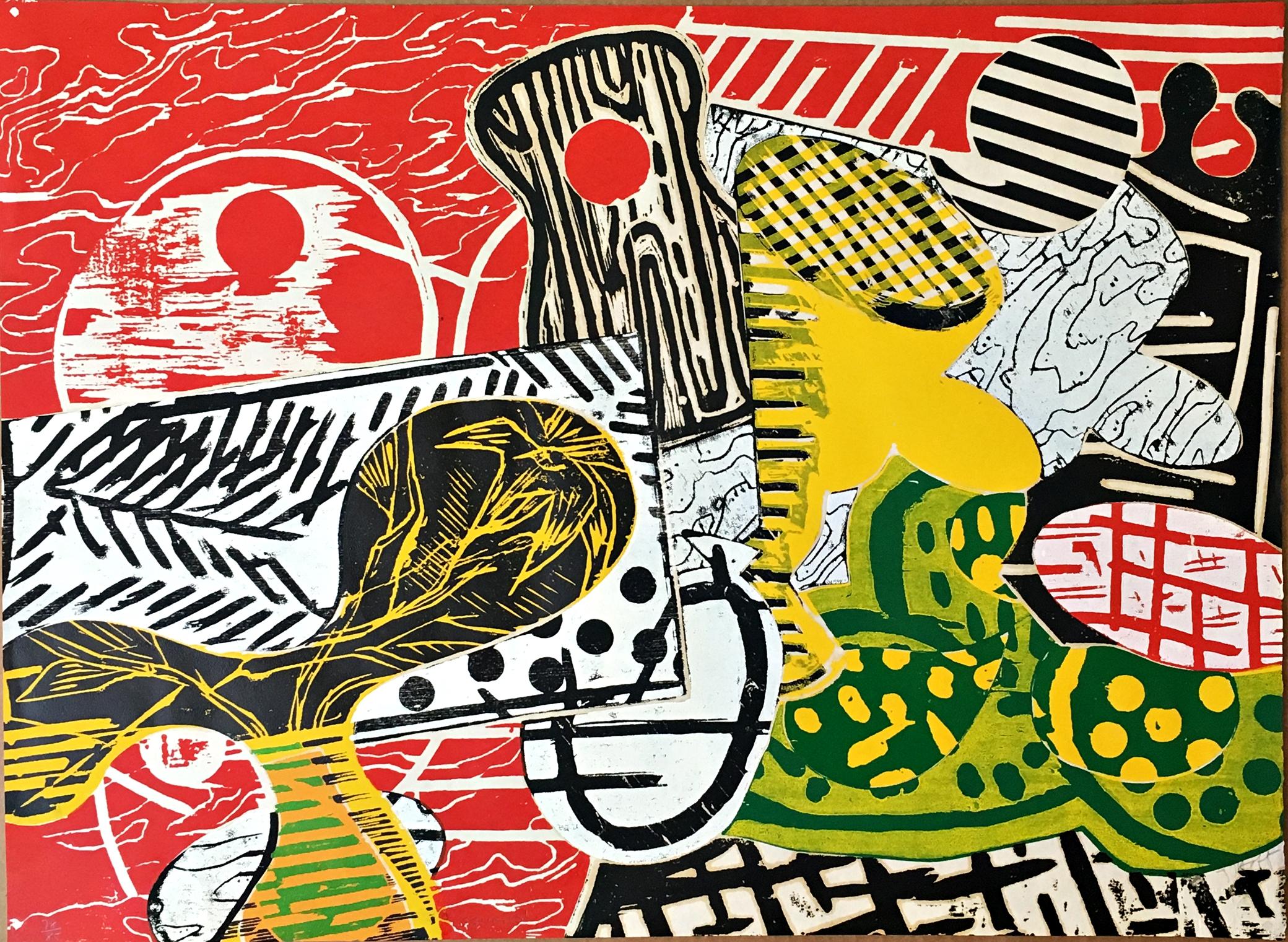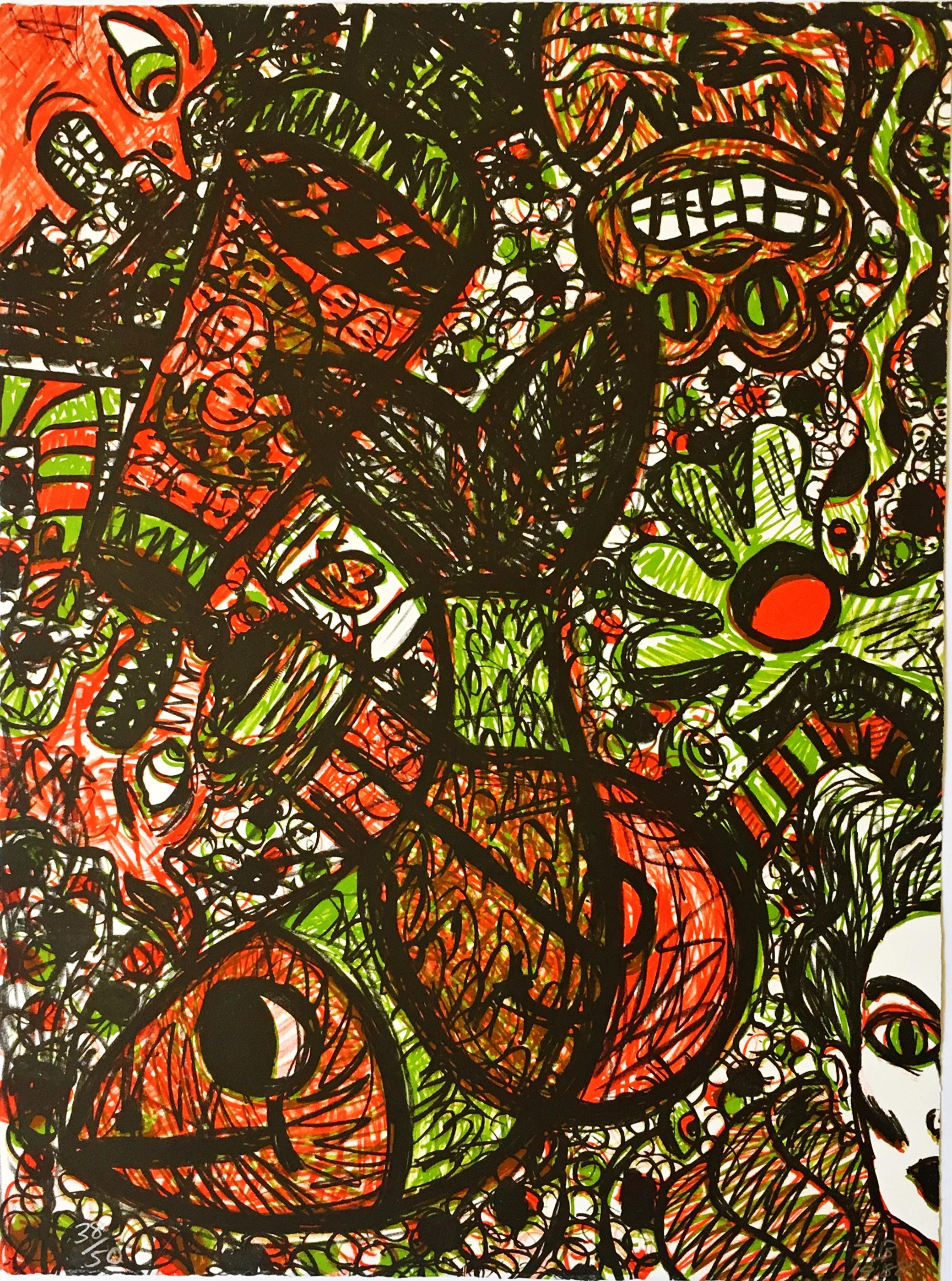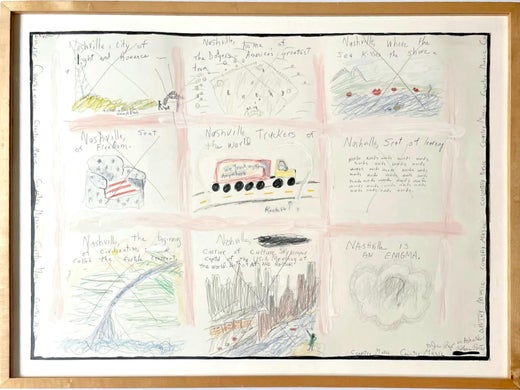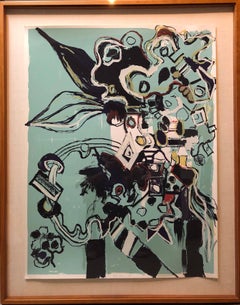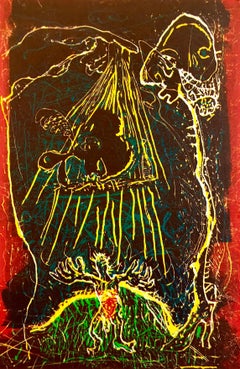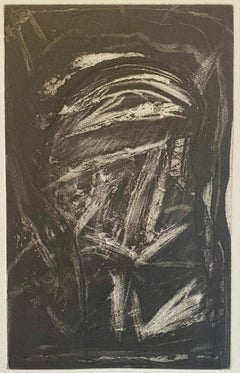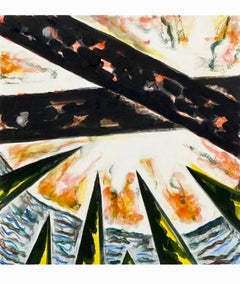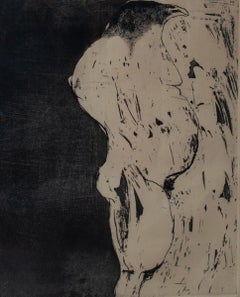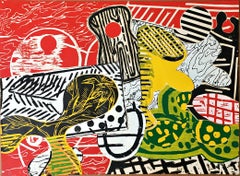Items Similar to Large Abstract Woodblock Print American Woman Modernist
Want more images or videos?
Request additional images or videos from the seller
1 of 8
Katherine PorterLarge Abstract Woodblock Print American Woman Modernist
$1,200
£908.35
€1,041.88
CA$1,686.73
A$1,856.23
CHF 973.39
MX$22,527.11
NOK 12,167.17
SEK 11,518.94
DKK 7,778.15
About the Item
Katherine Porter is an American artist born in Cedar Rapids, Iowa in 1941. She received her BA from Colorado College in 1963. Katherine Porter received an honorary doctorate from Colby College. She has shown twice in the Whitney Biennial and solo exhibitions at the Knoedler Gallery in London, the Nina Nielsen Gallery in Boston, and the Andre Emmerich and Salander-O'Reilly Galleries in New York. Her work is in the collections of the Metropolitan Museum of Art, Museum of Modern Art, Whitney Museum of American Art, Museum of Fine Arts in Boston, and the Tel Aviv Museum in Jerusalem.
Her exhibitions include biennials in 1976 and 1981 at the Whitney Museum of American Art in New York City; 1980 at the San Francisco Museum of Fine Arts; 1981, Dartmouth College, Hanover, New Hampshire; 1985, Brandeis University, Waltham, Massachusetts; and 1987 at the Sidney Janis Gallery, New York City.
- Creator:Katherine Porter (1941, American)
- Dimensions:Height: 26.5 in (67.31 cm)Width: 19 in (48.26 cm)
- Medium:
- Movement & Style:
- Period:
- Condition:
- Gallery Location:Surfside, FL
- Reference Number:1stDibs: LU38210940852
Katherine Porter
Katherine Porter (1941) is an American artist. Born in Cedar Rapids, Iowa in 1941, Porter is considered one of the most important contemporary artists associated with Maine. She resists categorization. Through the medium of painting and drawing her visually stunning canvases convey the conflict inherent in life. She expresses her ideas with a visual vocabulary that is "geometric and gestural, abstract and figurative, decorative and raw, lyric and muscular."
About the Seller
4.9
Platinum Seller
Premium sellers with a 4.7+ rating and 24-hour response times
Established in 1995
1stDibs seller since 2014
1,810 sales on 1stDibs
Typical response time: 1 hour
- ShippingRetrieving quote...Shipping from: Surfside, FL
- Return Policy
Authenticity Guarantee
In the unlikely event there’s an issue with an item’s authenticity, contact us within 1 year for a full refund. DetailsMoney-Back Guarantee
If your item is not as described, is damaged in transit, or does not arrive, contact us within 7 days for a full refund. Details24-Hour Cancellation
You have a 24-hour grace period in which to reconsider your purchase, with no questions asked.Vetted Professional Sellers
Our world-class sellers must adhere to strict standards for service and quality, maintaining the integrity of our listings.Price-Match Guarantee
If you find that a seller listed the same item for a lower price elsewhere, we’ll match it.Trusted Global Delivery
Our best-in-class carrier network provides specialized shipping options worldwide, including custom delivery.More From This Seller
View AllLarge Format Modernist Abstract Lithograph Silkscreen Print Woman Artist
By Lydia Dona
Located in Surfside, FL
1982-84 Hunter College, New York (M.F.A.)
1978-80 School of Visual Arts, New York
1973-77 Bezalel Academy of Art, Jerusalem (B.F.A.)
American, born in Romania
Lives and works in New York City
Solo Exhibitions
2008 Michael Steinberg Fine Art, New York
2006 Galeria Joan Prats, Barcelona
2005 Karpio + Facchini Gallery, Miami
Jacob Karpio Galeria, San Jose (Costa Rica)
2004 Michael Steinberg Fine Art, New York
2001 Marella Arte Contemporanea, Milan
2000 Von Lintel & Nusser, New York
Galerie Von Lintel & Nusser, Munich
1998 Galerie Thomas von Lintel, Munich
1997 Galerie des Archives, Paris
1995 Galerie Samuel Lallouz, Montreal
L.A. Louver, Los Angeles
1994 Marc Jancou Gallery, London
Galerie des Archives, Paris
1993 Galerie Barbara Farber, Amsterdam
Real Art Ways, Hartford (Connecticut)
1992 Tom Cugliani Gallery, New York
Galerie Marc Jancou, Zurich
Galerie des Archives, Paris
1989 Tom Cugliani Gallery, New York
Galerie Barbara Farber, Amsterdam
Studied at bezalel from 1973 to 1977. And it was a very fascinating time because it was a highly conceptually based school. Very much influenced by Joseph Beuys, and European Conceptualism, I didn’t really like the atmosphere there that much, because it was dominated by male painters like Jörg Immendorf, Marcus Lupertz, and a few others. then came to New York to study at SVA for two years. New York in 1978 was exciting. I was very lucky to be in a class that was full of very bubbly and very energetic artists like Keith Haring, Kenny Scharf, Tim Rollins, Moira Dryer, Frank Holliday, and Tom Cugliani (who later became one of my dealers).The eighties were dominated largely by Neo-Expressionist paintings. There were Germans, such as Baselitz, Kiefer, Richter, Penck, and the Italians, Clemente, Chia, Cucchi, Palladino as well as Schnabel, Fischl, Basquiat, Salle, and many others, but all of their paintings were figuratively based. But below the popular consent, there was a group of painters who were working more in the vein of what Stephen Westfall referred to as “Neo-Surrealism,” including George Condo, Jeffrey Wasserman, Kenneth Scharf, David Humphrey. However, I felt that Carroll Dunham and you were the only two painters who seemed to be less interested in the kind of narrative, lyrical, or let’s say, stationary composition. He belongs to the generation of Terry Winters, Elizabeth Murray, David Reed and Jonathan Lasker but in some strange way, if we’re looking back to the mid-eighties, we have to include New Image painters like Susan Rothenberg, Neil Jenney, and Robert Moskowitz who were working in between the figure and abstraction with a kind of condensation and compression, in relationship, lets say, to cartoon imagery. There are artists like Jeff Koons, or even Damien Hirst who took the Duchampian aspect and brought it into the continuity of his readymade. But for me, I see no difference between the crack in “Large Glass” and the drips in Jackson Pollock’s paintings. There was something that I felt in my own equation of the continuity between Paul Klee, Duchamp, Picabia, and, oddly enough, Clyfford Still.
What essentially is important is how different artists carry on a dialogue among themselves so that they can all keep their work vital. Whether from the abstract paintings of Richmond Burton, Fabian Marcaccio extending the borders of his paintings on to the wall, or Cady Noland’s early scattered installation, my own pre-occupation with machinery, urban environment, and the Duchampian models has always materialized in relationship to other forms of art making.
Selected Group Exhibitions:
2014 Drawing on Difference: An Ambition by Saul Ostrow and Lidija
Slavkovic, Studio Vendome Gallery, New York.
2013 Drawing on Habit: An Ambition by Saul Ostrow and Lidija Slavkovic,
South Carlton Beach and The Betsy-South Beach Exhibition Programs,
Art Basel, Miami Beach.
2013 Imprinted Pictures: Lydia Dona...
Category
1980s Abstract Expressionist Abstract Prints
Materials
Lithograph, Screen
Large Abstract Expressionist Figure Handmade Paper Etching Silkscreen Print
By Sam Messer
Located in Surfside, FL
This is done on a very interesting handmade paper (Japanese?) it is hand signed and numbered.
In this print the artist Sam Messer uses bold contrasting colors in a gestural manner. Messer's work, so apparently spontaneous or impulsive in its emphasis on highly dramatic gestural brushstrokes and intense color, is, in fact, carefully considered. The treatment of the composition conveys dynamic movement through the sweep...
Category
1980s Abstract Expressionist Abstract Paintings
Materials
Handmade Paper, Lithograph, Screen
American Abstract Expressionist Artist Melissa Meyer Aquatint Etching
By Melissa Meyer
Located in Surfside, FL
Melissa Meyer (American, b. 1946)
1984-1987, aquatint etching in black on wove paper, hand signed print, dated, and numbered from small edition of 10.
Unframed. size: 9.75'' x 6'',...
Category
1980s Abstract Expressionist Prints and Multiples
Materials
Etching, Aquatint
Monoprint Monotype American Modernist Gregory Amenoff Abstract Expressionist
By Gregory Amenoff
Located in Surfside, FL
Gregory Amenoff (Contemporary American abstract painter, b. 1948),
Monotype Monoprint (1990)
Hand signed in pencil lower right
plate: 16 x 16 inches
frame dimensions: 35 1/8 x 29 1/8 x 1 5/8 inches, wood frame with glazing
Provenance: Corporate Collection of Bank BNP Paribas
Gregory Amenoff is a painter who lives in New York City and Ulster County, New York. He is the recipient of numerous awards from organizations including the American Academy of Arts and Letters, National Endowment for the Arts, New York State Council on the Arts and the Tiffany Foundation. He has had over fifty one-person painting exhibitions in museums and galleries throughout the United States and Europe. His work is in the permanent collections of more than thirty museums, including the Whitney Museum of American Art, the Museum of Fine Arts in Boston, the Museum of Modern Art in New York and the Metropolitan Museum of Art. His work has the influence of both Abstract Expressionism and Pop Art in it, biomorphic forms in rich hues and thick textures with heightened colors and abstracted, organic forms, late American Modernism. He moved to New York in 1979, the artist rose to critical acclaim in the 1980s alongside Terry Winters, Bill Jensen, and Katherine Porter. The artist lives and works between New York, NY and his Hudson Valley residence. He works in woodcut, lithograph and monoprint techniques.
He was a collaborating artist illustrating Bradford Morrow, Bestiary along with Joe Andoe, James Brown, Vija Celmins, Louisa Chase, Eric Fischl, Jan Hashey, Michael Hurson, Mel Kendrick, James Nares, Ellen Phelan, Joel Shapiro,
Kiki Smith, David Storey, Michelle Stuart, Richard Tuttle, Trevor Winkfield, Robin Winters. Linoleum cuts with
pochoir and woodcuts for the Grenfell Press, New York. Amenoff served as President of the National Academy of Design from 2001-2005. He is a founding board member of the CUE Art Foundation in New York City and serves as the CUE Art Foundation's Curator Governor. Amenoff has taught at Columbia for the last eighteen years, where he holds the Eve and Herman Gelman Chair of Visual Arts and is currently the Chair of the Visual Arts Division in the School of the Arts. He is currently the Vice-President of the National Academy.
In 2011 he received the John Solomon Guggenheim Fellowship.
Museum Collections
Albright-Knox Art Gallery; Buffalo, NY
Art Institute of Chicago; IL
Baltimore Museum of Art;
Brooklyn Museum of Art; Brooklyn, NY
Butler Institute of American Art; Youngstown, OH
Cleveland Museum of Art; Cleveland, OH
Currier Gallery of Art; Manchester, NH
Frances and Sidney Lewis Foundation; Richmond, VA
Hood Museum of Art; Hanover, NH
Honolulu Academy of Art; Honolulu, HW
Kemper Museum of Contemporary Art; Kansas City, MO
Maier Museum of Art; Lynchburg, VA
Metropolitan Museum of Art; New York, NY
Milwaukee Museum of Art; Milwaukee, WI
Minneapolis Institute of Art; MN
Muscarelle Museum of Art, College of William and Mary; Williamsburg, VA
Museum of Fine Arts; Boston, MA
Museum of Modern Art; New York, NY
National Museum of American Art; Washington, DC
Neuberger Museum, State University of New York at Purchase; NY
New York Public Library, Spencer Collection...
Category
1980s American Modern Abstract Prints
Materials
Lithograph, Monoprint, Monotype
Large Abstract Expressionist Feminist Lithograph Incorporating Text ''FMSWNL''
By Joan Snyder
Located in Surfside, FL
''FMSWNL'' from the limited edition of 100. Pencil hand signed and dated.
Joan Snyder, (born April 16, 1940), is an American painter from New York. She is a MacArthur Fellow, a Gu...
Category
1980s Abstract Expressionist Abstract Prints
Materials
Lithograph
American Abstract Expressionist Artist Melissa Meyer Aquatint Etching
By Melissa Meyer
Located in Surfside, FL
Melissa Meyer (American, b. 1946)
1984-1987, aquatint etching in black on wove paper, hand signed print, dated, and numbered from small edition of 10.
Unframed. size: 9.75'' x 6'', 2...
Category
1980s Abstract Expressionist Prints and Multiples
Materials
Monoprint
You May Also Like
Leonard Baskin Abstract Woodcut, Signed
By Leonard Baskin
Located in New York, NY
Leonard Baskin (1922-2000)
Untitled, Late 20th Century
Woodcut
Framed: 32 x 24 1/4 x 1/4 in.
Edition 26/50
Signed and numbered lower right
A highly respected draftsman, printmaker, ...
Category
Late 20th Century Abstract Abstract Prints
Materials
Woodcut
"I" Abstract Woodblock Print by Charlie Hewitt
By Charlie Hewitt
Located in Long Island City, NY
Artist: Charlie Hewitt, American (1946 - )
Title: Untitled - i
Year: circa 1995
Medium: Woodblock, Signed and Numbered in Pencil
Edition: 100
Image Size: 16 x 20 inches
Size: 18.5 x ...
Category
1990s Abstract Expressionist Abstract Prints
Materials
Screen
Squash scarce Abstract Expressionist woodcut print, Signed/N, top female artist
By Judy Pfaff
Located in New York, NY
Judy Pfaff
Squash, 1985
Woodcut on wove paper
Signed, numbered 78/85, dated and titled on the front with artist's and publisher's blind stamps.
21 3/4 × 29 3/4 inches
Publisher
Cente...
Category
1980s Abstract Expressionist Abstract Prints
Materials
Woodcut
Untitled, expressionistic woodcut print, from the Art Against AIDS Portfolio
By James Bettison
Located in New York, NY
James Bettison
Untitled, from the Art Against AIDS Portfolio, 1988
Woodcut on paper with deckled edges. Hand signed. Numbered 38/50. Dated. Printer's and Publisher's Blind Stamp.
20...
Category
1980s Contemporary Abstract Prints
Materials
Woodcut, Pencil
"J" Abstract Woodblock Print by Charlie Hewitt
By Charlie Hewitt
Located in Long Island City, NY
Artist: Charlie Hewitt, American (1946 - )
Title: Untitled - J
Year: circa 1985
Medium: Woodblock, Signed and Numbered in Pencil
Edition: 100
Size: 20 in. x 24 in. (50.8 cm x 60.96 cm)
Category
1980s Abstract Expressionist Abstract Prints
Materials
Screen
"C" Abstract Woodblock Print by Charlie Hewitt
By Charlie Hewitt
Located in Long Island City, NY
Artist: Charlie Hewitt, American (1946 - )
Title: Untitled - C
Year: circa 1995
Medium: Woodblock, Signed and Numbered in Pencil
Edition: 100
Size: 20 in. x 24 in. (50.8 cm x 60.96 cm)
Category
1990s Abstract Expressionist Abstract Prints
Materials
Screen
More Ways To Browse
American Woodblock
Expressionist Woodblock Prints
American Woodblock Prints
A R Penck
Antoni Miro
Chryssa Chinatown
Erik Bulatov
Exhibition Poster 1983
Giuseppe Capogrossi
Indian Miniature Painting On Ivory
Joan Miro Ubu
Jyoti Bhatt
Leo Castelli Lithograph
Long Art Work
Miro Ubu
Rothko Prints
Rubber Stamp Portfolio
Alain Le Yaouanc
